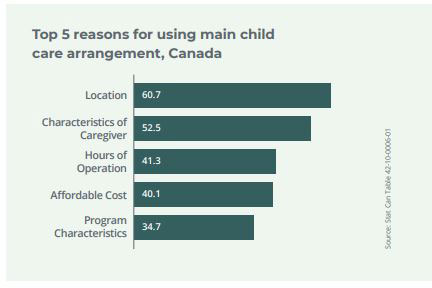New Child Care Data
Although child care policy is a provincial domain, the federal government budgeted a transfer to the provinces of $7.5 billion over eleven years starting in 2016. Funding is primarily directed toward one type of care—spaces in centre-based care. The universal system in Quebec is often praised as a model to emulate. Yet the recent Statistics Canada Survey on Early Learning and Child Care Arrangements, 2019 and follow up analysis Early Learning and Child Care for Children aged 0 to 5 years: A Provincial/Territorial Portrait show that parents use a variety of arrangements, and the majority of parents receive no benefit when provinces fund centre-based care.
Child care policies should be equitable for all families, regardless of the type of care they choose. Federal policy-makers must respect the diversity of choices parents make.
Principles of Equitable Child Care Policy: Diversity and Neutrality
Diversity: Parents Rely on Diverse Care Arrangements
Child care is the care of a child regardless of who provides the care. Parents rely on diverse care options for their children. Nationally, about 60 percent of children under six years old are in nonparental care. Of these, about 52 percent are in child-care centres or in a preschool program. This means that when we consider all children in Canada under the age of six—those in parental care and those not—31 percent are currently in centre-based care or preschool.1 A majority of children under six in Canada currently receive no benefit from public funding for centre-based spaces.
Type of child care arrangement among those in non-parental care, household population aged zero to five years

Neutrality: Policy-Makers Must Respect Diverse Parental Needs
Finding care can be challenging, but according to Statistics Canada, nearly 64 percent of Canadian parents who use non-parental child care report no problem finding care. Rather than funding one form of care in response to a perceived crisis, policy-makers should take a neutral, evidence-based approach and respect the diversity of care parents choose.

Parents choose care based on their needs. According to the survey, the top reasons parents who use non-parental care select the type of care they do are location (60.7%), the characteristics of the individual providing care (52.5%), and the hours of operation (41.3%). Furthermore, many parents depend on inhome care or relatives, while about 40 percent of parents with children under six in Canada currently do not use non-parental care.
A Positive Vision
The federal approach to Canadian family policy has been heterogeneous, relying on a variety of policy levers in support of families. This allows for greater flexibility among families. Parental leave policies, tax credits, and cash benefits to parents all contribute to more options for parents. Additionally, federal policy-makers should
- Maximize freedom within the Multilateral Early Learning and Child Care Framework. Preferably money would go to parents, but where money is designated for programs, maximum freedom must be allowed for provinces to act in accordance with citizens’ desires and regional needs. Separate plans for child care in Indigenous communities seems a hopeful sign in this regard.
- Define child care as the care of a child, no matter who does it. Excluding parental care from current definitions of child care results in inequitable funding among families.
- Increase the flexibility of parental leave. Allow for parents on leave to receive a higher level of employment income, before EI benefits are clawed back. Many parents would like to work up to twenty hours per week while on leave, but the current system doesn’t make this feasible.
Although child care is primarily a provincial issue, the federal government can develop a narrative that encourages child care policies that are equitable for all families, regardless of the type of care families choose.

